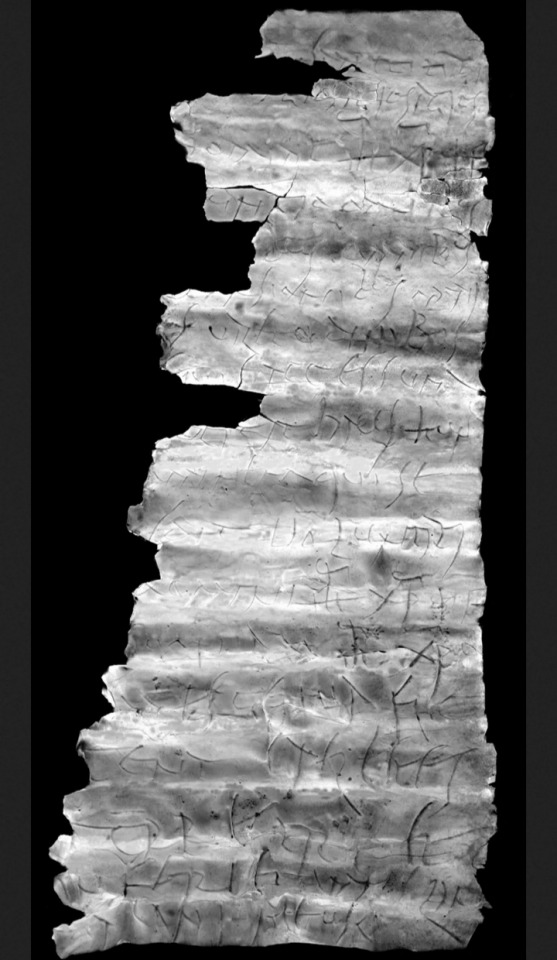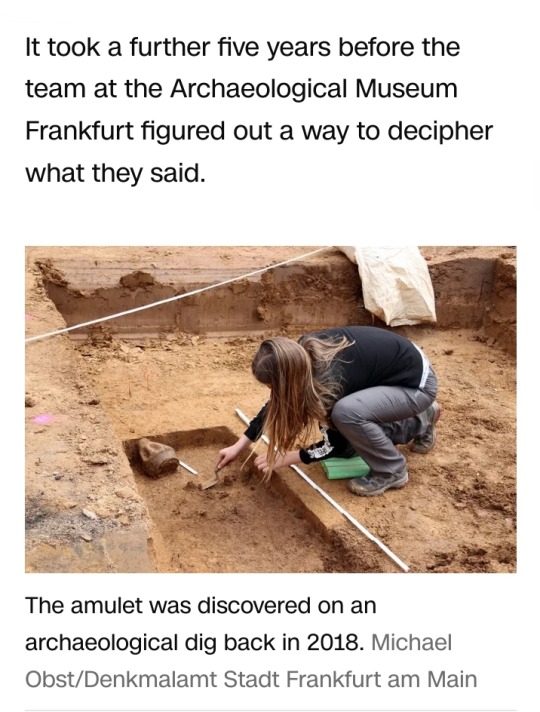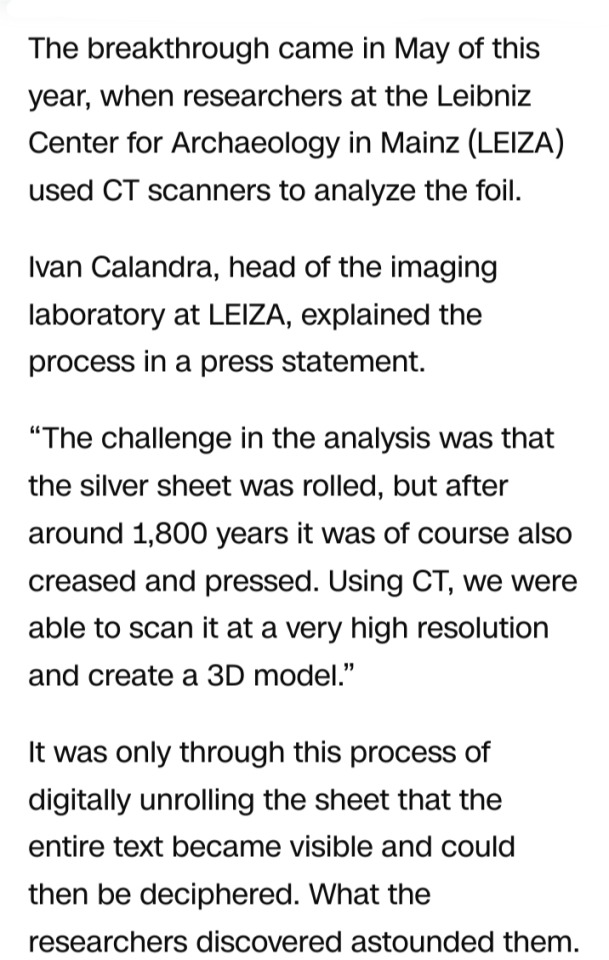#frankfurt silver inscription
Explore tagged Tumblr posts
Text









“(In the name?) of St Titus.
Holy, holy, holy!
In the name of Jesus Christ, Son of God!
The Lord of the World
Resists (to the best of his ability?)
All attacks(?)/setbacks(?).
The God(?) grants the well-being
Entry.
This means of salvation(?) protects
The human being who
Surrenders to the will
Of the Lord Jesus Christ, the Son of God,
Since before Jesus Christ
All knees bow to Jesus Christ: the heavenly
The earthly and
The subterranean and every tongue
Confess (to Jesus Christ).”
There is no reference in the text to any other faith besides Christianity, which would also have been unusual at this time.
According to the Frankfurt Archaeology Museum, reliable evidence of Christian life in the northern Alpine regions of the Roman Empire only goes as far back as the 4th century AD.
‘Fantastic find’ made possible by modern technology
Wolfram Kinzig, a church historian and professor from the University of Bonn, helped Scholz to decipher the inscription.
“The silver inscription is one of the oldest pieces of evidence we have for the spread of the New Testament in Roman Germania, because it quotes Philippians 2:10–11 in Latin translation,” Kinzig explained in an interview published on the University of Bonn’s website.
“It’s a striking example of how Biblical quotations were used in magic designed to protect the dead,” said Kinzig.
Peter Heather, a professor of medieval history at King’s College London with a specialist interest in the evolution of Christianity, described the discovery as a “fantastic find.”
Heather, who wasn’t involved in the research, told CNN:
“The capacity to be able to decipher the writing on that rolled-up piece of silver is extraordinary. This is something that’s only possible now with modern technology.
If they’d found it 100 years ago they wouldn’t have known what it was. Silver amulets are probably going to contain some kind of magical scroll but you don’t know what – it could be any religion.”
He added:
“You’ve got evidence of Christian communities in more central parts of the empire but not in a frontier town like that in Roman Germany so that is very unusual, well it’s unique. You’re pushing the history of Christianity in that region back.”
#silver amulet#amulet#germany#nida#frankfurt#archaeology#christianity#christian history#roman empire#artifact#ct scan#phylactery#archaeological museum frankfurt#Leibniz Center for Archaeology in Mainz (LEIZA)#jesus#st. titus#st. paul#frankfurt silver inscription
28 notes
·
View notes
Text
"The inscription consists of sentences praising Jesus Christ, including the words: 'Holy! Holy! Holy! In the name of Jesus Christ, Son of God. … Protect the man who surrenders himself to the will of the Lord Jesus Christ, Son of God, since before Jesus Christ every knee bows'.”

#ancient Christianity#archeology#trisagion#Lord Jesus Christ#God#Frankfurt Silver Inscription#Germany#Son of God
9 notes
·
View notes
Text
popularmechanics.com
"1,800-year-old #silveramulet [buried in a German] grave...has 18 lines of text written in Latin on just 1.37 inches of silver foil. That could...rewrite the known history of #Christianity in the #RomanEmpire"
#FrankfurtInscription
https://www.popularmechanics.com/science/archaeology/a63204262/silver-amulet-roman-christianity/
0 notes
Text
Now here’s a divine development.
Just ahead of the holidays, archaeologists have “digitally unrolled” a 1,800-year-old silver amulet to decipher an inscription that’s being hailed as the oldest known evidence of Christianity in Europe.
Authentic evidence of pure Christianity north of the Alps has never existed before now. And the findings have the potential to change holy history forever.
“It will force us to turn back the history of Christianity in Frankfurt and far beyond by around 50 to 100 years,” said Mike Josef, mayor of Frankfurt, Germany, where the artifact was exhumed.
“The first Christian find north of the Alps comes from our city,” added Josef. “We can be proud of that, especially now, so close to Christmas.”
The amulet housed a “wafer-thin” foil, measuring 1.4 inches, and featuring text referred to as the “Frankfurt silver inscription.”
It was found beneath the chin of a man’s skeleton at a burial site on the outskirts of Frankfurt in 2018. However, the ancient wording, dating back to between 230 and 270 — when the predominant religions in Europe were Judaism and paganism — has been virtually illegible until now.
Specialists from the Leibniz Center for Archaeology (LEIZA) used computer tomography (CT) scans to decode the 18-line engraving, which declares Jesus Christ the “Son of God.”
“In the name of Saint Titus. Holy, holy, holy! In the name of Jesus Christ, Son of God! The Lord of the world resists with [strengths] all attacks [or setbacks]. The God grants entry to well-being. May this means of salvation protect the man who surrenders himself to the will of the Lord Jesus Christ, Son of God, since before Jesus Christ every knee bows: those in heaven, those on earth and those under the earth, and every tongue confesses (Jesus Christ),” reads the translation, per DailyMail.
The deific discovery closely trails the recent decrypting of the Meggido Mosaic, a 1,800-year-old relic that says, “Jesus is God.” It also follows the July 2024 unearthing of a nearly 2,000-year-old manuscript that details the earliest known account of Christ’s childhood.
To crack the code on the Frankfurt silver inscription, which is written in Latin, LEIZA experts used sophisticated technologies on the extremely delicate scroll.
“The challenge in the analysis was that the silver sheet was rolled, but after around 1,800 years, it was of course also creased and pressed,” Ivan Calandra, an archaeologist at LEIZA, said in a statement. “Using CT, we were able to scan it at a very high resolution and create a 3D model.”
The pros reportedly placed individual segments of the scan together, piece by piece, until most of the words were visible.
However, there are said to be a few gaps in the text — which is being dubbed “purely Christian” as it spotlights Jesus Christ and Saint Titus, a missionary and church leader, but avoids pagan themes as well as elements of Judaism.
Professor Markus Scholz, an archaeologist from Goethe University in Frankfurt, helmed the deciphering efforts.
“I called in experts from the history of theology, among others, and we approached the text together, piece by piece, and finally deciphered it,” said Scholz, who was surprised that the etchings were in Latin.
“Such inscriptions in amulets were usually written in Greek or Hebrew,” he noted.
And while little is known about the man who was buried with the amulet, scientists reportedly believe that he was a devout Christian — although believers of the faith were still subject to persecution at the time of his death.
According to insiders, the late Jesus-lover likely wore the amulet on a cord around his neck for protection before transitioning into the afterlife. His grave also boasted an incense bowl and a jug made of fired clay.
Researchers consider him the “first Christian north of the Alps,” and speculate that there could be more historical, untapped Christian burial sites around Europe.
“This extraordinary find affects many areas of research and will keep science busy for a long time to come,” said Ina Hartwig, Frankfurt’s head of culture and science.
“This affects archaeology as well as religious studies, philology and anthropology,” she continued. “Such a significant find here in Frankfurt is really something extraordinary.”
#nunyas news#well that's all kinds of cool#doen't upend a thing either#just confirms what we already know
36 notes
·
View notes
Photo



A rare German silver synagogue-form tzedakah box, maker’s mark BM possibly for Berthold Muller, Frankfurt, signed Heun Fec, circa 1907
quadrangular architectural form on ball feet, one side with a relief view of the Friedberger Anlage Synagogue, Hebrew and German inscriptions
height: 15.2 cm
279 notes
·
View notes
Text

Passover Set
Ludwig Yehuda Wolpert, designed Frankfurt, Germany, 1930, manufactured New York, United States, 1978
The Jewish Museum, New York
"The aesthetic principles advocated by the Bauhaus in the 1920s-that form and function were mutually dependent, that fine design should be aimed at mass production, that ornament should be banned-pervaded international artistic thought for much of the twentieth century. At first considered radical by many, the numerous Bauhaus designs that are still produced today testify to their viable aesthetic and practical values.
Ludwig Wolpert is the first metalworker to apply these progressive principles to the fabrication of Jewish ceremonial art. His Passover service, a copy after a lost original designed in 1930, may be his masterpiece. Its conception and execution aptly express the ideas generated by the Bauhaus School, first during its years at Weimar and then in Dessau. Wolpert gleaned many of these concepts from his Bauhaus-trained teacher Leo Horowitz and also became aware of burgeoning Bauhaus design through publications and colleagues.
The form of this set is based on earlier, lavishly decorated examples. Following Bauhaus precepts of minimal embellishment and maximum visual effect, Wolpert pared the multilevel server down to its essential functions in a highly calibrated play with contrasting materials. Three circular tiers above a conforming silver base are joined at equidistant points by vertical ebony and silver mounts. Notched to support the glass shelves, the mounts double as handles. Horizontal silver bands that separate each tier slide open to reveal a space, within which the symbolic matzah can be placed. The cutout Hebrew inscription "I will lift the cup of salvation, and call upon the name of the Lord" appears on the glass-lined silver goblet. This receptacle holds the wine symbolically set aside for the prophet Elijah. Practical, industrially replicable, cylinder-shaped glass dishes, meant to contain the ritual foods, have been set into precious silver mounts.
The design of the tiered platter, aside from the cutout inscription, is founded entirely on the appeal of its high-contrast materials. Wolpert's inspiration for his combination of wood, glass, and metal may have come from Josef Albers's berry dishes and teacups of 1923-25. Yet Wolpert applies these ideas to an infinitely more complex object with a rationality and a thorough understanding of the relationship of weighted objects in three-dimensional space. This latter conception conforms with the thinking of Moholy-Nagy, an important teacher at the Bauhaus, who strove to derive uncompromising new forms that could also be mass-produced. Although the fabrication of this seder plate was too difficult for large-scale production, it was carefully replicated several times.
A substantial part of Wolpert's later work, including Hanukkah lamps, memorial lights, and kiddush goblets, was indeed designed for mass production. Ultimately, the artist successfully adapted Bauhaus philosophy to the production of well-designed ritual domestic wares still available today."
69 notes
·
View notes
Text
German Mint Upgrades Equipment
By Richard Giedroyc
It’s far from being the first time, but the 650-year-old Stuttgart Mint in Germany is getting three new coining machines. Its “partner,” the other state-run mint in Baden-Wurttemberg, will receive an additional machine also. The Karlsruhe Mint was founded in 1827. Both facilities are operated under an umbrella as the Die Staatlichen Münzen Baden-Württemberg, or State Mints of Baden-Wurttemberg, which in turn operates these mints on behalf of the German Federal Ministry of Finance.
The State Mints of Baden-Wurttemberg represent about 40 percent of all German euro coin production. The two minting operations together employ about 80 people.
Schuler Group will be providing the mints with 150-ton Horizontal MRH presses capable of producing up to 850 coins per minute. These presses can strike singular or bimetallic coins as well as produce coinage blanks.
According to Schuler website information, “For example, at the turn of the 19th Century, it was possible to produce up to 60 coins per minute on Schuler presses – an astonishing achievement for the time. Today, high-performance machines from Schuler achieve performance levels of up to 850 coins per minute. Our customer-focused practical research and development are continuously improving the efficiency of our machines. Ongoing new developments – such as the inscription around the edges of bimetallic coins – supplement our extensive product range.”
The website says of the MRH press, “This model series is especially well suited for high-volume minting of coins. The small number of coin-specific change parts ensures short changeover times and broad flexibility of application. Worldwide, Schuler is the sole supplier of this system.
“The fixed connection of the coining punch and slide link drive with the counterbalance of masses assures a longer service life for each press. The presses are mounted on vibration-dampening elements. Each press offers “high-efficiency thanks to [a] reliable transport system from blank feeding to exit-side ejection of coins.”
Schuler was founded by Louis Schuler as a metal-working shop in Göppingenin in 1839. The company sent its first coining presses to China in 1895. There have been many innovations since.
According to the Schuler website, “Today Schuler is increasingly concerned with the design of digital value-added services for its customers.”
The first coins minted in Stuttgart at what is today part of the State Mints of Baden-Wurttemberg were authorized by Eberhard II, Count of Wurttemberg in 1374. In The Coinage of the European Continent, W. Carew Hazlitt mentions gold florins issued authorized by Ulric VI, Duke of Wurttemburg during the early 16th century as well as later coins. Hazlitt also indicates that the coinage for the dukes of Wurttemburg were almost entirely composed of gold or silver prior to 1840. Hazlitt notes Stuttgart also being identified by other sources as Stugardia.
In Coins of the World, RAG Carson adds, “The [early] coinage…was also exclusively of small silver heller with types of two stags heads.”
The Stuttgart Mint retained its role when Wurttemberg joined the German Empire in 1871. The mints of the German Empire were at Berlin (A mintmark), Hanover (B), Frankfurt-am-Main (C), Munich (D), Dresden (E), Stuttgart (F), Karlsruhe (G), Darmnstadt (H) and Hamburg (J) after 1876. The Stuttgart Mint continued to operate after Wurttemberg was merged with Baden to form the federal state of Baden-Wurttemberg in 1951.
Despite both mints being operated by the same government organization, Stuttgart-minted coins continue to carry the “F” mintmark, while coins struck at Karlsruhe use the “G” mintmark.
The post German Mint Upgrades Equipment appeared first on Numismatic News.
0 notes